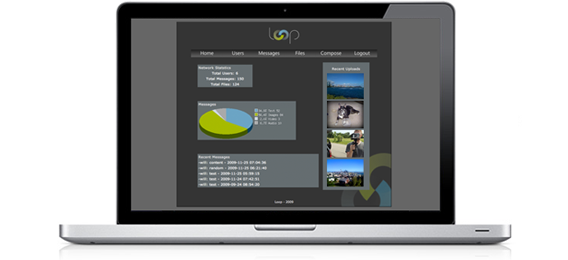Loop Social Network
This project was undertaken as part of a scoping study to determine the feasibility of cross compatible mobile application development using the Qt C/C++ framework. Development was undertaken during a summer internship with BT and focused on assessing the current abilities of the framework and suitability for commercial use. To effectively asses this a mobile multimedia social networking platform was constructed which in turn tested the ability to gain low level hardware access to features such as the camera and microphone. The application was then ported to various platforms identifying the current level of cross compatibility available between handsets.
Due to the fragmented nature of software development for mobile devices there is very little code reuse between platforms which greatly increases development costs. The Qt framework is a new cross compatible development platform for Windows Mobile, Maemo and Symbian S60 devices. Like other similar technologies such as Java Micro Edition the quality of the ported application varies greatly and so the aim was to asses the possible pitfalls with this technology. To achieve this it was necessary to test access to low level functionality such as the camera and networking abilities and so the social networking application was developed to encompass these abilities.
The system is similar in style to that of Twitter where users have relationships and can in turn broadcast messages to those who are following their feeds. Therefore each user registers with the network either online or through the mobile application and finds users for which they wish to be kept informed about. As the user then uploads video, pictures, sound or text it is displayed to all the paired friends feeds. To achieve this the application communicates via a PHP API that is connected to a sql database storing related message, friendships and file data. The application uses standard cellular network access to request data over HTTP where it is gathered at the device as XML for processing. This is then interpreted and further calls are made to the API requesting user specific graphics and multimedia. Due to certain technical difficulties with the current implementation of the Qt framework the backend API also transcodes data into a common file format that can then be displayed within the application accordingly. The application was initially developed for the Windows Mobile platform using platform specific code for hardware access including camera and microphone. All networking functionality such as FTP for data upload and appropriate HTTP post commands were implemented using the specific Qt framework functionality and helped identify the current pitfalls of the framework. The completed application was ported between Windows Mobile and the Symbian S60 platform where UI related issues were discovered. Many of this issues were due to the current level of development with the platform with it being a pre release Alpha edition. Through this testing we were able to identify the capabilities of the framework and make recommendations for possible future development once the framework has matured further.
Throughout this period it because apparent that although applications were cross compatible to an extent, it still lacked the focus on mobile application constraints relating to the UI. As the Qt framework has been available on the desktop environment from the late 90s it's a well developed technology and works with few anomalies. As this is a fairly new transition to the mobile market specific mobile considerations have been lacking. This have subsequently been addressed with the use of Qt Mobile Extensions which can be used to implement all low level access to hardware functionality. Therefore greater use of location techniques can be made improving friendship maps and decreasing the use of platform specific code.
Completion Status
Is It DoneMore Info
Loop Admin, Design Colour Scheme, Qt framework
Multi Media
